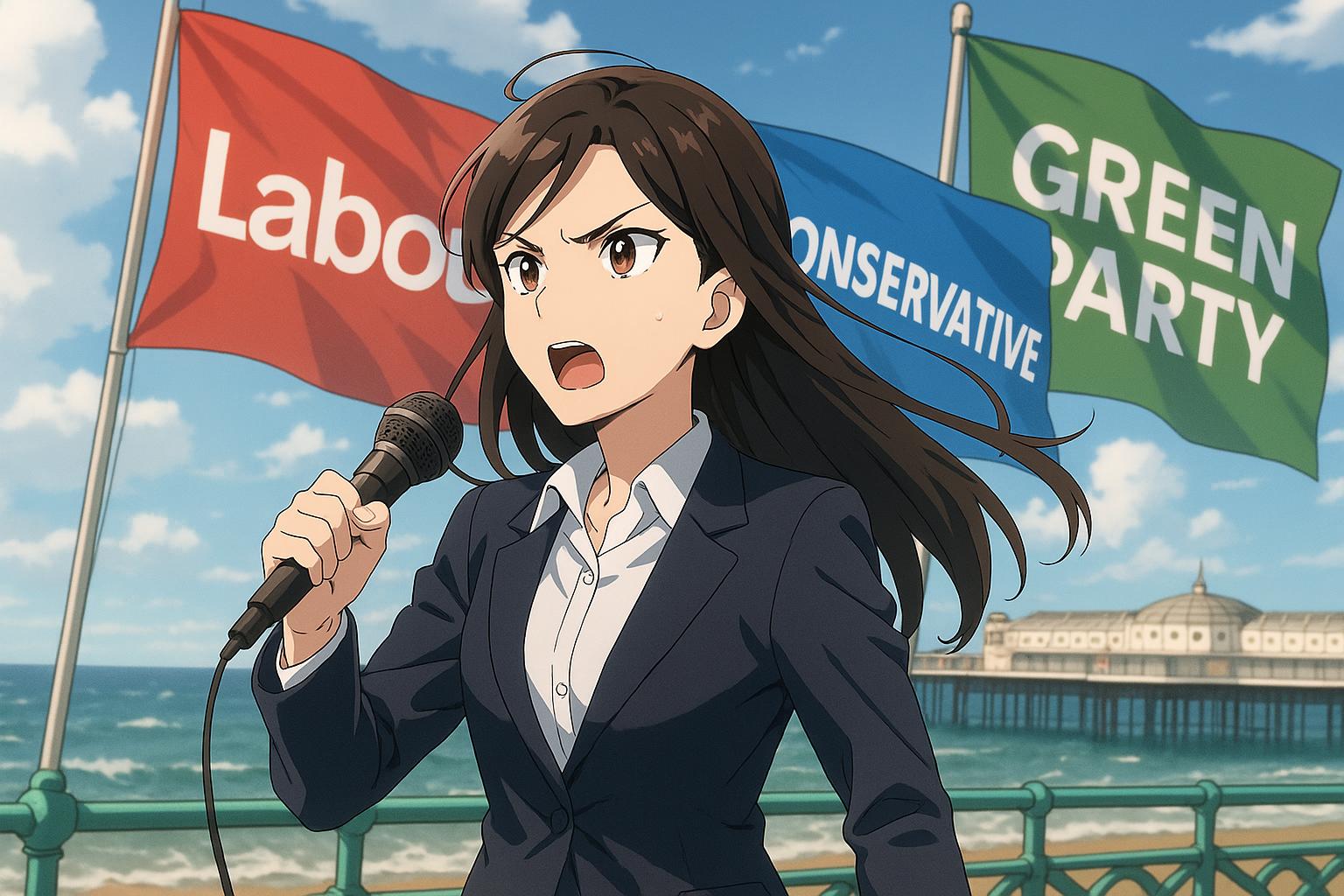After historic Labour gains in 2023, Brighton and Hove’s political landscape is shifting as voters grow disillusioned with traditional parties, turning to a nascent right-wing alternative that threatens to reshape local power dynamics ahead of the 2027 elections.
Shifts are afoot in Brighton and Hove’s political landscape, marked by a growing disillusionment among voters who once gravitated towards the Green Party and Labour. While the Labour Party recently reveled in their historic victory in the 2023 local elections—securing 38 seats compared to just 16 previously, effectively edging out the Greens—the illusion of security is fleeting. The emergence of a robust alternative offers a fresh political dynamic that could unravel Labour’s hard-won gains, posing significant threats both to them and the Greens.
In recent discussions within the community, a notable number of voters are reevaluating their allegiances, not returning to the traditional parties, but turning their eyes toward the emerging option on the right. Though still in its infancy, this shift signals a potential realignment of political loyalties that may disrupt the entrenched powers in the upcoming electoral cycle. Observers have aptly noted, “Little drops of water and little grains of sand, make for mighty oceans and mighty lands,” capturing the essence that localized discontent could coalesce into meaningful support for a more pragmatic political alternative by 2027.
Following Labour’s significant gains, which marked the first majority in two decades, the political tide may turn once more. The dismal performances of the Greens, who now find themselves with a mere seven councillors—losing major players like council leader Phélim Mac Cafferty—further complicates the picture. What seemed like a Labour stronghold may soon become a battleground, and the party faces an uphill struggle as it grapples with repercussions of unfulfilled promises both regionally and nationally, especially under the faltering leadership of Keir Starmer.
One pressing issue looming over Labour is the proposed Sussex-wide Mayor. Far too many critics are labeling this initiative as a strategic blunder that could deepen Labour’s challenges, leaving local councillors to wrestle with the growing uncertainty. Typically, incumbent councillors lean on their established personal voter base during tough elections; however, many in Brighton and Hove lack the name recognition necessary to secure their positions amid such turbulence.
As the electoral landscape continues to shift, projections for 2027 are increasingly filled with peril. The notion that Labour could fall to under 18 seats, while the political alternative rises to between 24 and 28 newly elected representatives, sends a stark warning. Observers astutely forecast that without transformative national changes, Labour will descend into disarray, its proud numbers threatened by the weight of Starmer’s discontented leadership and the party’s current diminishing public perception.
For the Greens, the potential rise of a political challenger harbors adverse implications. Should they find themselves facing a new political rival outshining them, their victory would hardly be a cause for celebration. As they approach the formidable task of drafting a legal budget, they may be forced to implement drastic cuts to essential local services, thus transferring the blame for austerity directly onto their lap—a reality that voters are increasingly likely to connect with Labour’s wider national failures.
As a former councillor remarked, the horizon for Labour in Brighton and Hove is indeed fraught with challenges. What began as a celebratory moment in 2023 could devolve into a historical low by 2027. Labour’s previous commanding parliamentary majority has all but crumbled, with allegations of failing to meet constituents’ expectations now prevalent. Many point to the failures in management, from economic strategies to cuts in critical support that resonate with the electorate.
Indeed, the urgency of an alternative voice looms large over Labour’s future, marking a challenge that could prove more advantageous for the right than previously anticipated. Starmer’s decisions risk inadvertently fuelling discontent that resonates with a disenfranchised base, enhancing the distinct appeal of a robust alternative. As the political landscape grows perilous, Labour’s countdown to potential collapse becomes ever more imminent, transforming a period that should herald renewal into a cautionary narrative about squandered opportunities.
As Brighton and Hove navigate these turbulent times, the political narrative is destined to evolve, fundamentally influencing the governance of the city and the daily lives of its residents. The forthcoming elections will speak volumes—not only about the entrenched party loyalties of the past but also about a rapidly changing political climate reflecting the anxieties and aspirations of the electorate.
Source: Noah Wire Services
- https://www.theargus.co.uk/news/25178809.reform-gains-will-come-expense-labour-brighton-hove/?ref=rss – Please view link – unable to able to access data
- https://www.theargus.co.uk/news/23504709.brighton-elections-full-list-results-labour-gain-majority/ – This article reports on the 2023 Brighton and Hove local elections, where the Labour Party secured a majority on the city council for the first time in two decades. Labour increased its seats from 16 to 38, while the Green Party’s representation dropped from 20 to 7. The article details the election results across various wards, highlighting significant gains for Labour and losses for the Greens, including the defeat of Green council leader Phélim Mac Cafferty and deputy leader Hannah Allbrooke.
- https://www.theargus.co.uk/news/23504722.brighton-elections-labour-ready-lead-historic-win/ – Following their historic victory in the 2023 Brighton and Hove local elections, the Labour Party is poised to lead the city council. The article discusses the party’s plans to deliver for residents and outlines the gains made from the Green Party in several wards, including Preston Park, Hanover and Elm Grove, Hollingdean and Fiveways, and Brunswick and Adelaide. Notably, Green council leader Phélim Mac Cafferty and deputy leader Hannah Allbrooke lost their seats to Labour candidates.
- https://www.brighton-hove.gov.uk/news/2023/labour-win-overall-majority-brighton-hove-local-elections – This official announcement from the Brighton and Hove City Council confirms the results of the 2023 local elections, where the Labour Party won 38 seats, securing an overall majority. The Green Party won 7 seats, the Conservatives 6, Brighton & Hove Independents 2, and an independent candidate secured 1 seat. The article provides detailed results for each ward and notes a voter turnout of 40.8% from an electorate of 204,255.
- https://www.brightonandhovenews.org/2023/05/05/its-a-labour-landslide-in-brighton-and-hove/ – This article reports on the 2023 Brighton and Hove local elections, highlighting Labour’s significant victory with 38 out of 54 seats, marking the first majority in 20 years. The Greens were reduced to 7 seats, with council leader Phélim Mac Cafferty losing his seat. The article also mentions the election of Bella Sankey as the new leader of the council and discusses the implications of the results for the city’s political landscape.
- https://www.brightonandhovenews.org/2024/07/05/election-result-labour-hold-hove/ – In the 2024 general election, Labour retained the Hove constituency with an increased majority. Peter Kyle, the Labour candidate, secured 27,209 votes, defeating Green candidate Sophie Broadbent, who received 7,418 votes. The article provides a breakdown of the vote counts and discusses the implications of the result for the local political scene, noting the impact of Reform UK on the Conservative vote.
- https://www.centreforcities.org/blog/local-elections-2023-reflections/ – This analysis from the Centre for Cities reflects on the 2023 local elections, focusing on Brighton and Hove. The article notes that Labour gained control of the council, increasing its seat share from 16 to 38, while the Green Party’s representation dropped from 20 to 7, marking their worst result since 2003. The piece also highlights the loss of key Green Party figures, including council leader Phélim Mac Cafferty and deputy leader Hannah Allbrooke.
Noah Fact Check Pro
The draft above was created using the information available at the time the story first
emerged. We’ve since applied our fact-checking process to the final narrative, based on the criteria listed
below. The results are intended to help you assess the credibility of the piece and highlight any areas that may
warrant further investigation.
Freshness check
Score:
9
Notes:
The narrative references recent events and political shifts in Brighton and Hove, including the 2023 local elections and projections for 2027. It does not appear to be recycled from older articles based on the specific local context discussed.
Quotes check
Score:
8
Notes:
The quote ‘Little drops of water and little grains of sand, make for mighty oceans and mighty lands’ is not sourced to a specific author or date, but it is a well-known proverb. The lack of a directly attributed quote from a specific individual makes it difficult to confirm its originality.
Source reliability
Score:
8
Notes:
The narrative originates from The Argus, a well-established local newspaper. While local sources can be reliable, they may reflect regional perspectives and biases.
Plausability check
Score:
7
Notes:
The claims about political shifts and emerging alternatives are plausible given the volatile nature of local politics. However, specific projections for 2027 are speculative and cannot be verified without further data.
Overall assessment
Verdict (FAIL, OPEN, PASS): OPEN
Confidence (LOW, MEDIUM, HIGH): MEDIUM
Summary:
The narrative is generally plausible and fresh, reflecting recent political developments. However, it includes speculative projections and relies on local perspectives, which may not be universally applicable or accurate.













